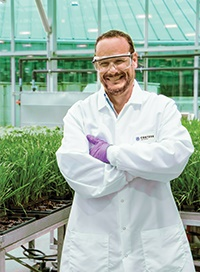 It takes years for a crop protection product to go from a potential idea in the lab to a new product aiding farmers in their battle against weeds, insects and diseases. To help us understand how the process works, we’ve enlisted Mauricio Morell, global biology leader for rice, Corteva Agriscience, to answer a few questions for us.
It takes years for a crop protection product to go from a potential idea in the lab to a new product aiding farmers in their battle against weeds, insects and diseases. To help us understand how the process works, we’ve enlisted Mauricio Morell, global biology leader for rice, Corteva Agriscience, to answer a few questions for us.
Which comes first, a discovery of a new chemistry or the search for chemistry as a solution to an agronomic challenge?
“Our search is based on the current needs in the market. We ‘discover’ based on our customers’ needs, including farmers and consumers. Customer-facing functions are closely aligned with our discovery teams, so it is clear where the gaps and market needs are that need to be fulfilled, along with the desired attributes of a new active ingredient. We search for products based on those agronomic challenges and market needs.
“Our discovery effort is 100% focused on discovering new solutions specifically to meet identified needs. We do not discover something and then figure out how we make it fit in the market. At Corteva Agriscience, new active ingredients are built to meet customer, market and consumer needs.”
How long does it take to bring a new product to market?
“It is a highly complex process, requiring collaboration, multiple functions and thousands of people over many years to bring solutions through the pipeline. The time can vary, and it may also be extended as we better understand our new technologies and their fit in new crops and market segments. We estimate 10-12 years, from the moment we mark a product as a new discovery until the moment it is commercially introduced in the first and key launching geographies. Of course, this could fluctuate, based on registration processes and geography.”
What is involved in that process?
“Resources, functions, people, teamwork and coordinated effort are all required to bring a product to market. Many functions work together to ensure a product will hit the market successfully and become a useful and valuable tool for farmers.
“From the early discovery phases, chemists and biologists work together identifying, characterizing and optimizing the right molecules, and sharing their findings within cross-functional teams to evaluate the potential for new products. From a single hit in an early stage screening, we may make and evaluate thousands of product analogues to find one with the characteristics needed to move forward. This one compound will then move to the predevelopment and development stages. Interfunctional teams then work together for many years moving the molecule through its journey of further characterization at the global level.
“Each potential product must be evaluated for efficacy and rates required, spectrum of control and crop safety. An extensive regulatory evaluation ensures safety and registrability, and a validation of chemical routes to manufacture cost effectively and sustainably determine producibility. Also evaluated are formulation development and optimization, field performance to validate translation of greenhouse activity to field, intellectual property and commercial review, among others.
“Regulatory, manufacturing, reg-labs, supply, formulation technology, research and development, marketing, commercial and legal departments all join efforts in the development and launching of robust and reliable crop protection tools and solutions that will support world agriculture.”
How do you decide which discoveries make their way to market as crop protection products?
“Remember, our discovery targets are established based on customer and market needs, which also include consumer needs. It may be an agronomic challenge such as a new pest, resistance to existing solutions, lack of existing solutions or the exit of an existing solution from the market. It could also be that existing solutions lack the desired attributes to meet customer and consumer needs, creating demand for products with the required attributes. We also have sustainability attributes that we strive for with any of our new active ingredients.
“Discoveries should be aligned to our discovery goals and desired attributes, which are in turn aligned to customer and market needs, including consumer needs. We have specific milestones on all aspects (commercial, biology, chemistry, regulatory, legal, etc.) that must be addressed to advance to the next stage and, ultimately, to register and launch a new product.
“Criteria are also defined by the environmental and toxicology profile of the molecule, which, ultimately, will define its registrability potential and how it fits on our strategy of launching safe and sustainable tools for today’s and tomorrow’s agriculture.”
The More You Grow
Find expert insights on agronomics, crop protection, farm operations and more.